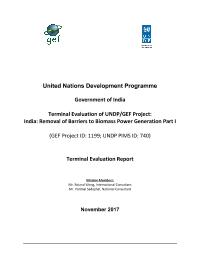
TE India Biomass Electric Power Generation Project Phase 1
Completedon 9 Dec, 2017
Evaluation Plan
Planned End Date
Oct 2017
Evaluation Type
Project
Management Response
Yes
Evaluation Budget
$30,000
Evaluation Title
TE India Biomass Electric Power Generation Project Phase 1
Atlas Project Number
00043810
Plan Period
Status
Completed
Type
Project
Plan Date
5 Oct, 2017
Completion Date
9 Dec, 2017
Budget
$30,000
Expenditure
$28,000
Source of Funding
Project Budget
Management Response
Yes
Quality Assessment
Yes
Joint Programme
No
Joint Evaluation
No
GEF Evaluation
Yes
Expand
Stakeholders
Ministry of New and Renewable Energy (MNRE)
Countries
India
Comments
Atlas Project Number
00043810
Plan Period
Status
Completed
Type
Project
Management Response
Yes
Plan Date
5 Oct, 2017
Quality Assessment
Yes
Completion Date
9 Dec, 2017
Joint Programme
No
Joint Evaluation
No
Budget
$30,000
GEF Evaluation
Yes
Expand
Expenditure
$28,000
Stakeholders
Ministry of New and Renewable Energy (MNRE)
Source of Funding
Project Budget
Countries
India
Comments
Yes
Expand
Output 1.1. National and sub-national systems and institutions enabled to achieve structural transformation of productive capacities that are sustainable and employment - and livelihoods- intensive
1: Environment & Sustainable Development
2: Others



The Project goal was to “improving electricity supply without increasing GHG emissions through widescale application of biomass power generation technologies” and its goal of “accelerating adoption of environmentally sustainable biomass power technologies for captive and distributed biomass materials in niche areas (including captive power use and open access power sale), through demonstration of model investment projects (MIPs) demonstrating development models and establishment of sustainable business/support services network and undertaking enabling activities for removal of the key barriers”.